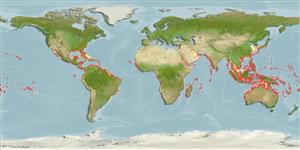Common names from other countries
Environment: milieu / climate zone / depth range / distribution range
Écologie
marin récifal; profondeur 2 - 50 m (Ref. 9680), usually 3 - 20 m (Ref. 40849). Subtropical; 35°N - 31°S, 180°W - 180°E (Ref. 55213)
Circumtropical. Eastern Pacific: San Diego, California, USA to Chile, including the Galapagos Islands (Ref. 37955). Western Atlantic: Bermuda, Massachusetts (USA), and northern Gulf of Mexico to Brazil (Ref. 7251). Eastern Atlantic: 30°N to 23°S (Ref. 6951). Western Indian Ocean: Red Sea to Madagascar, Reunion and Mauritius (Ref. 33390). The reports in the Mediterranean Sea are doubtful (Ref. 50345).
Taille / Poids / Âge
Maturity: Lm ? range ? - ? cm
Max length : 91.0 cm TL mâle / non sexé; (Ref. 2850); common length : 40.0 cm TL mâle / non sexé; (Ref. 26999); poids max. publié: 2.8 kg (Ref. 40637)
Épines dorsales (Total) : 0; Rayons mous dorsaux (Total) : 14 - 17; Épines anales: 0; Rayons mous anaux: 14 - 16. Body robust; teeth united in each jaw but without a central division; body covered with long, sharp spines, folded backwards when body not inflated; 16 to 20 spines between snout and dorsal fin; dorsal region of caudal peduncle spiny; back, flanks and fins light brown with numerous dark spots; belly spiny (Ref. 55763). Spines long. Body grayish tan, with small black spots, but no large dark blotches. Belly white, surrounded by dusky ring (Ref. 26938). About 20 spines in an approximate row between snout and dorsal fin (Ref. 13442).
Occur in lagoon and seaward reefs to at least 50 m. Commonly seen in caves and holes in shallow reefs (Ref. 26938, 48637). Juveniles to about 20 cm are pelagic. Adults benthic (Ref. 30573). Solitary and nocturnal that feed on hard shelled invertebrates like sea urchins, gastropods, and hermit crabs (Ref. 9680). Generally common (Ref. 9710). Not normally used as food (Ref. 3717). Reached a life-span of 10 years and a length of 69 cm in the McGinty Aquarium (E. Dashiell, pers. comm 2004), suggesting a preliminary K=0.12.
Life cycle and mating behavior
Maturities | Reproduction | Spawnings | Egg(s) | Fecundities | Larves
Randall, J.E., G.R. Allen and R.C. Steene, 1990. Fishes of the Great Barrier Reef and Coral Sea. University of Hawaii Press, Honolulu, Hawaii. 506 p. (Ref. 2334)
Statut dans la liste rouge de l'IUCN (Ref. 130435)
CITES (Ref. 128078)
Not Evaluated
Menace pour l'homme
Poisonous to eat (Ref. 4690)
Utilisations par l'homme
Pêcheries: intérêt commercial mineur; Aquarium: Commercial
Outils
Articles particuliers
Télécharger en XML
Sources Internet
Estimates based on models
Preferred temperature (Ref.
115969): 23.3 - 29, mean 27.4 (based on 1822 cells).
Phylogenetic diversity index (Ref.
82804): PD
50 = 0.5313 [Uniqueness, from 0.5 = low to 2.0 = high].
Bayesian length-weight: a=0.08710 (0.04269 - 0.17770), b=2.76 (2.58 - 2.94), in cm Total Length, based on LWR estimates for this species & (Sub)family-body (Ref.
93245).
Niveau trophique (Ref.
69278): 3.7 ±0.0 se; based on diet studies.
Résilience (Ref.
120179): Faible, temps minimum de doublement de population : 4,5 à 14 années (tmax>10; preliminary K=0.12).
Fishing Vulnerability (Ref.
59153): High vulnerability (56 of 100).
